|
Home
Articles
For Sale
Mares
Stallions
Our Dogs
Contact
us
Miniature Horse Foaling
Problems = Dystocia
I Am Ranch Miniature
Horses is sharing with you what we do to maintain the health of our
horses. We
advise you to consult your veterinarian before making any changes in
your horse's health care. The information found on our
website is not to supersede the advise of your veterinarian. I AM Ranch
Miniature Horses cannot be held liable for the care of your horse(s).
Breeding season is approaching and as
it does, my research continues on how to deal with problems during the
birthing process. We have been blessed to not have any problems yet, but
know that it may happen. I want to share what we are learning and will
continue to update this page. I am always open to hearing what others
have dealt with if anyone wants to email me more. It is
IMPERATIVE that you keep a close watch on your expectant mares. You just
never know when it's going to happen.
I can't say enough about the book
called, The Complete Book of Foaling. We had read that and then
went to Dr. Laura Harris' clinic on dystocia and miniature horse foaling. She is THE
vet in Phoenix that all of the big mini breeders have used for years and
years. Some of these mini breeders have had hundreds of foals.
After the book and after her clinic,
it seems to me that the most important thing to remember when you
are in the beginning stages of foaling is to assess the position of
the foal. If the foal is presented correctly, thank the Lord and grab a bucket of popcorn.
But, there are many
presentations where you push the foal back in and then try to
reposition him. Then, there are some presentations (red bag and back
hooves out) where you should start pulling immediately. Then, there were
some presentations, where you should immediately call the Vet. All of these actions boil down to you being able
to assess the foal's presentation accurately and quickly.
One encouragement was
that in many of the cases you have a bit of time because the
foal's umbilical cord is not being pinched. In the two cases I
mentioned above the foal's air supply is gone (or going as in
back hooves out) and you are against the clock. You
have only 6 minutes to get baby out, and he takes his first breath of
air 30 seconds after his air supply is gone.
The Complete Book of Foaling
reviews the presentations and tells you how to maneuver the foal
with helpful diagrams. Having twine (or I have shoelaces from
the dollar store) on hand is important to tie to one of those
pasterns if you have to push baby back in. Having other helpers
on hand also seems important to me.
And as a homeschooling mom,
The Complete Book of Foaling can also serve as a Biology
text!!
The notes below are the notes that I plan on having
with me the night our mares deliver, just incase a mare is having
problems with dystocia. Remember that I am only 14
years old and these are only my tips. You should not take my
recommendations, but call a vet!!
by Lisa Dales
(age 14)
I. Normal Birth
A. You should see two forelegs and a
nose
-
The two forelegs should be staggered
3”-6” apart
-
The nose should be right behind the
hooves, about the level of the knees, with the ears the level of the elbows
-
If the mare has been pushing for 20
minutes and there is no progress, enter mare to assess
problem or call for help
B. Stage I – Positioning
-
Starts with the mare going into labor and
ends with the water breaking
-
This time period can range from a short
interval up to 24 hrs and still produce a live foal
C. Stage II – actual birth
-
Starts with water breaking, ends with
delivery of foal
-
Duration from 15 minutes - 1 hour. If
foal is not
out in an hour, CALL VET
-
White sac should appear after a couple
hard contractions; if there is no sac, reach in mare and find out why
D. Stage III – Passing of placenta
-
Duration: 5- 45 minutes is normal
-
If placenta is not delivered within 3
hrs, CALL VET
II. Abnormal Presentations of foal (dystocia)
A. Critical Things to Remember:
-
Before putting your hand in the mare, ALWAYS WASH carefully
and LUBE generously!
-
If you know there is
dystocia, keep mare from pushing
and straining, for all
she is jamming the foal tighter against the pelvic wall.
if a
mare is walking, she cannot push!
-
Pointing the mare downhill may
help, too
-
If you pull, only pull with the mare's contractions. You can actually
cause the tissues that line the birth canal to bunch up and make delivery impossible.
-
Always think about the arc-like pathway that a foal must follow to
emerge from the birth canal. He is delicate, as are the inner tissues of
the mare.
B.
Presentations where you
MUST PULL THE FOAL OUT NOW!
In the following three
presentations, you must always get the foal out
immediately. If not, the foal will be oxygen deprived and will
probably die. In all three presentations, the umbilical cord is being
pinched so the foal is getting no air from that source. After the
umbilicus is cut off, you have 30 secs before the foal’s first breath
and 6 minutes before brain damage.
1.
Red Bag
Click here to read more and see videos of red
bag births
-
You will see red, terry cloth like sac
coming out of mare
-
The foal is inside of the red sac
and white sac. You must cut the
red sac, go inside that, rip the white sac, go inside that and
pull the foal out FAST! Remember, ALWAYS pull a foal out
downwards, towards the hocks of the mare.
2.
Backwards Foal
(hind legs coming first)
-
You know that you
have a backwards foal because the
hind
legs come first. The soles of the feet
are pointing up, and
not down as
usual. The umbilicus is being pinched on pelvic rim.
-
Grasp the legs, and pull toward the
mare’s hocks.
3. Hip lock
(Foal's pelvis is locked on the mare’s pelvis. Four
approaches for unlocking....

-
First approach – cross foal’s front legs, and while pushing
foal back into mare
(only push during a time of no contractions) twist the front legs in a
rotational movement. If the foal doesn’t
“pop” out, cross legs the other way and try again
-
Second approach – Roll mare onto back. Have helpers hold her on
back. Grasp the foal’s
forelegs. Even though you are still pulling towards the
mare’s hocks, you are now pulling towards
your waist because
the mare is on her back. Baby should pop out
-
Third
approach – grasp foal’s front legs and pull down
to the
left, then down to the right, slowly trying to walk foal
through birth canal. Alternate the way you are pulling,
down to left, down to right.
-
Fourth
approach - Grasp foal's forelegs and attempt to rotate foal 180 degrees, pull
foal upwards and out.
C. Presentations to CALL THE VET,
don’t try it yourself!!!!
In the following
presentations, you could hurt mare and/or foal if you try to do it alone.
While waiting for the vet to arrive, walk the mare slowly
around the stall. A mare can’t push and walk at the same time.
Have your trailer hooked up, deeply bedded and
ready to haul her in.
1. Full Breech (Backwards with no legs coming)

2. Upside Down Breech
(backwards & upside down)
3. Back
(spine) of foal first, also called transverse
-
Mare will be pushing…nothing coming, you
stick your hand in,
and hit a solid wall of foal, the foal’s back.
4.
All 4 feet coming at same
time, another transverse
D. Presentations that may
need my intervention....or a nearby
vet.
-
One forefoot or foreleg deflected back
(most common
dystocia )(Read Lisa's story of a birth by
clicking here)
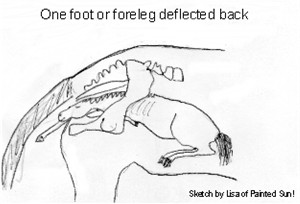
-
I will see only one leg and a nose.
-
Tie a clean shoe string around the
visible pastern. Next, push the head and leg back into uterus a little ways. Slide your clean, well lubricated hand into mare, with palm towards center. Locate hooked leg, slip two fingers behind knee, pull up, then towards the middle of foal’s chest, then
out. If the leg does not come,
try
grasping
toe of hoof and bringing it forward.
-
(If the foal’s left leg is missing, use
your left hand with the palm towards center of mare) Whenever you are moving foal’s legs inside the mare, protect her uterus from the sharp hooves by cupping the foal’s hoof in your hand.
2. Both
forelegs back (second most common dystocia) (Jewel's baby presentation)
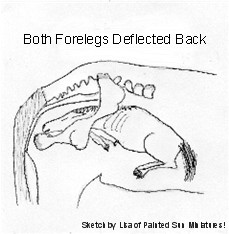
-
You will see the nose, but there will be
no legs
-
If the foal has a blue tongue, don’t
worry; that is normal in this situation
-
Enter with your palm towards center and
do the same process as written above on both legs instead of just one leg
3. Head caught on
pelvic rim
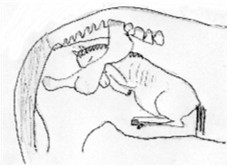
-
The legs may or may not be in birth
canal.
-
Tie string to visible pasterns and then
reach in mare. Find the
foal’s two mandibles, then run your hand down his face to his chin. Grasp under chin while having your helper push the foal back into uterus. (with each contraction, the foal’s head is being jammed harder and harder into the pelvic rim. That is why the helper must push foal back to undo the blockage) with your hand under the chin, gently but firmly pull on it and unhook from the rim. Once the head straightens, the foal will deliver without
further
ado.
4. Head & neck turned
to one side
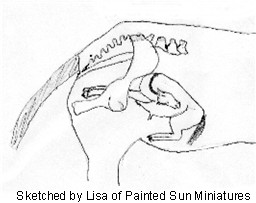
-
This presentation may look like the one
above, but when you put
your hand
in, on one side of the foal will be a
mass of neck. Tie strings to the
pasterns, and, while helper is
pushing foal back,
slide hand
along neck to chin. Grasp chin and
gently straighten head.
5. Upside Down
-
You will see the soles pointing upwards,
telling you that the
foal is either upside down or backwards. Discern position by
entering and
trying to find head or hocks. If there is
a head, the foal is
upside down.
-
This position may correct itself. Allow
time for the mare’s rotational
contractions to turn foal. Allow time
for mare to lay down and roll
to position foal before getting
worried.
-
If intervention is necessary, first
put hand in and re-check foal’s
position to make sure that only 2 legs are in the birth canal. If
hind leg is there, do not push
foot directly back in!(Read
section 6 on how to unhook a third foot) Foal will be tipped to one
side. This is because the rotational contractions are trying
to turn the
foal that direction. Work with the
pre-established direction of
the foal. If foal is tipped to your left, grasp foal’s
legs and
cross right leg over left. Hold the legs
crossed, and wait
for
mare’s contractions to pull. (mare should
by laying down). When
she pushes, pull and twist firmly but
gently. Rolling the foal happens gradually, not suddenly. Don’t
pull when the mare is not having a contraction, but in between
contractions, don’t let the foal
slip back, hold all progress you have
made.
6. One hind foot coming under chest (Dog-sitting position)

-
Instead of the normal two front feet and
a nose, there will be 3 front feet and a nose. The first thing you have
to do is figure out
which leg is the back leg. Put hand in
and feel for hocks or run
hand down foal’s front legs to find
chest.
-
Once you find the back foot, put two
fingers behind
-
pastern/ankle
try to LIFT HOOF over pelvic rim
while your helper pushes
foal back. As soon as you feel any
movement or release, slide
your hand with palm upwards and
catch the sharp
hoof tip as it
falls,
protecting the mare’s uterus
7. Forelegs
over head/ears
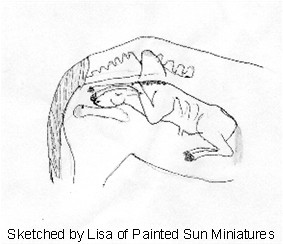
-
Foal will be coming out, except for that
the hooves will be on top
of
the nose instead of the nose on top of the hooves. Lube well and go
in with your palm towards the center
-
Once you locate the knees, which will be
hooked over the ears,
gently lift legs from head into normal position
Need more reading??
Click
here for a foaling calculator
Click
here for a foaling kit list
Click
here for ideas of what to do 30 days prior to foaling
Click
here for a description of a redbag birth
Click here for notes about dystocia during foaling
Read
product testimonials here
Click here
for our post foaling check
list
We have kept extensive foaling journals to help
others.....look on the
articles page
Home
Articles
For Sale
Mares
Stallions
Our Dogs
Contact
us
|







